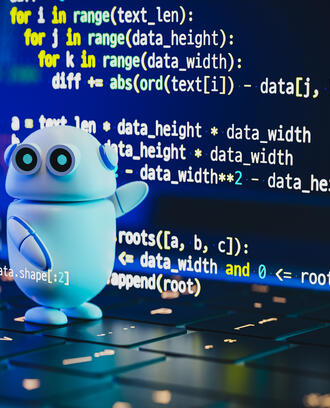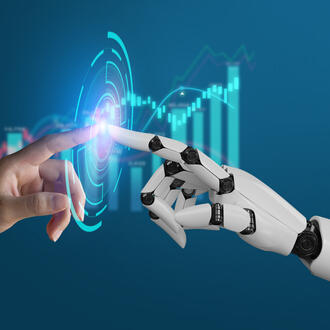Accenture is a global leader in professional services, with over 700,000 employees and clients across 120 countries. Renowned for its work in strategy, technology, and digital transformation, the firm has recently expanded into the robotics and space technology sectors. As they explore how to use AI to accelerate new products and businesses in these areas, they’re continuing to work with MIT—this past spring, with two teams of students in MIT’s first ever Generative AI (GenAI) Lab course.
Sponsored by the MIT Initiative on the Digital Economy (IDE), this new course—Generative AI Lab (GenAI-Lab)—offers students a hands-on Action Learning experience in applying AI tools to real-world business challenges, while helping hosts develop new capabilities and ideas.
“These projects are fantastic illustrations of the value of the work between Accenture and MIT that’s been going strong with IDE and other programs for five years,” says Prashant Shukla, associate director of growth and strategy at Accenture.
Project 1: satellite tracking chatbot
Over 50% of all low Earth orbit (LEO) satellites currently in space have been deployed in the past two years, marking an acceleration in a domain where Accenture sees significant growth potential. These LEO satellites, typically orbiting below 1000 kilometers, are widely used for earth observation, communication, and imaging, making them essential for projects like Starlink and other global connectivity efforts.
However, this surge in space-related missions created new operational demands. Prior to hosting a GenAI-Lab team, Accenture’s consultants were increasingly tasked with making sense of satellite tracking and orbital dynamics. The existing process they followed was time-consuming and inefficient, requiring consultants to navigate complex, fragmented tools—often manually parsing physics-heavy data for which many lacked the technical background. There was a need for a user-friendly agent that could serve as a domain-aware assistant—capable of interpreting natural language queries and returning reliable, scenario-specific satellite data.
Query example: What's the closest satellite to Paris right now?
Response: The closest satellite to Paris right now is STRIX-1 at a distance of 511.51km.
With guidance from Srikumar Subramanian, associate director of technology at Accenture Innovation, a group of MIT Sloan students created a tool to do just that.
The new AI chatbot they developed may democratize access to satellite tracking capabilities by automating data parsing, visualization, and spatial reasoning. More specifically, it intelligently parses user queries, determines whether code execution is necessary, generates and runs relevant code, and returns clear, human-readable outputs. Its simplicity can potentially empower Accenture consultants—regardless of their technical expertise—to quickly generate actionable insights for clients in sectors like telecommunications, defense, and logistics.
“If an astronomer wants to see if a satellite is crossing their area of observation or a researcher wants to schedule an observation of a particular satellite, they want to know where to look and when. This chatbot can quickly tell them,” says Subramanian.
For the MIT students, learning about agentic AI workflows was the highlight of the project.
“Beyond crafting prompts and prototypes, I learned that true impact comes from orchestrating robust processes, integrating real-time data ingestion, error handling, and clear user feedback loops,” adds Brimar Olafsson, MBAn ’25. “This holistic perspective on bridging technical feasibility with user experience will definitely shape how I approach AI solutions in my future career.”
The main takeaway for Maxime Basse, MBAn ’25, was realizing the significant gap between a working demo and a production-ready agentic AI system, especially when large language models are involved. “Although we had a functioning prototype early on,” he says, “most of our effort went into refining prompts and handling edge cases to ensure reliability and robustness for real-world use.”
In recognition of the students’ forward-thinking approach to optimizing space asset planning by leveraging generative AI to solve a complex logistical challenge, the team won first place in MIT’s inaugural GenAI-Lab competition.
Project 2: robots in the workplace
The humanoid robot market is expected to reach USD 16,929.6 million by 2032 with a CAGR of 34.2%, according to SkyQuest. Since humanoid robots are getting cheaper and showing a lot of new potential, Accenture’s clients are asking if they are a good investment or not, says Alpana Dubey, innovation research principal director at Accenture Labs.
[Our clients] want to know how robots might be used in their industry, which part of their business process could be automated, and how much it would cost.
Before Accenture hosted a GenAI-Lab team of students, it relied on lengthy studies that took weeks and tied up their engineering teams. The firm is looking at offering its manufacturing and service clients a faster, reliable way to evaluate whether a humanoid robot could replace manual labor on a given task (a person unscrewing a bolt, opening a lid, etc.). Working with Dubey and her team, a group of MIT Sloan students worked towards creating an early prototype of a Humanoid Robotic Process Advisor—shrinking the evaluation to minutes.
“It’s been incredible to watch today’s large language models tackle something as complex and open-ended as video-to-ROI analysis with such ease,” says Siddharth Chilukuri, MBA ’25.
What really stood out is that no single model can handle end-to-end. It takes a smart orchestration of multiple models, each focused on a specific component, to make the whole solution work seamlessly. While there’s still a journey ahead before production-grade deployment, this proof of concept clearly illuminates the path for both the technology and industry.
The new Advisor prototype is a tightly orchestrated pipeline that fuses multimodal AI, rule‑based logic, and domain data that lays out the path for a rapid analysis of tasks, automatable by humanoids, and ROI assessment. This rapid triage lets teams discard non‑viable tasks instantly and focus on detailed pilot efforts on the top automation opportunities, cutting engineering study time significantly. By allowing users to input a brief video of a human task in action, they can find out if a robot could do it, and how efficiently. Added to that, the students developed a cost-projection model that provides users with a five-year investment and feasibility payback graph.
"One key takeaway for me was realizing that problems like evaluating the cost-benefit of robotic automation from industrial video footage, which were previously too complex or time-consuming, are now within reach, thanks to GenAI. But getting meaningful results isn’t magic,” notes Siddharth Mehta, MBA ’25.
Large language models need clear context, structure, and direction to be effective. GenAI opens up incredible possibilities, but it also requires us to learn entirely new ways of working with this new kind of intelligence.
Advancing technology and business
The new tools that both MIT teams helped to develop not only meet Accenture’s business needs, but also enhance the company’s reputation as a forward-thinking leader in the space and robotics consulting domains, offering faster response times, cost-effective solutions, and higher-quality insights to their clients.
“Both projects were greatly appreciated,” says Shubhashis Sengupta, Accenture Innovation managing director and senior technology research executive, who notes that he is bringing up the students’ proposals to the firm’s businesses to see if they could be brought to market.
“At Accenture, we want to incubate new business,” adds Subramanian. “Projects like these definitely help us understand the sectors better and generate new ideas we can explore with our partners and clients and be taken to scale.”



